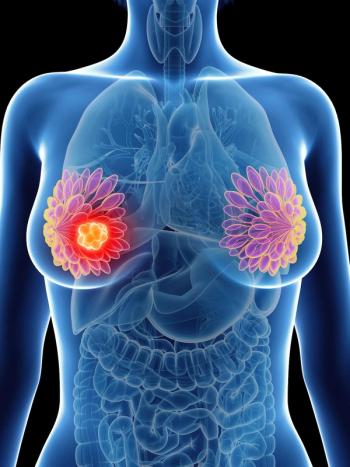
- ONCOLOGY Vol 24 No 4
- Volume 24
- Issue 4
Adjuvant Endocrine Therapy in Premenopausal Women With Operable Breast Cancer: Understanding the Issues
Research and development of adjuvant therapies for premenopausal women with endocrine-responsive breast cancer is unfortunately lacking.
Dr. Richard Love, in response to a recent review article, has prepared a commentary that implies that such reviews are often lacking in breadth because they only describe recent and current large clinical trials. It is understandable that a scholar like Dr. Love, who has made clinically relevant contributions in the treatment of younger women with breast cancer, focuses the attention of the reader on issues relating to therapies for this cohort. Dr. Love describes seven areas that are often not addressed in review articles, often criticizing clinical trial designs and their limited geographic populations along the way.
We agree that there is a body of “other provocative and emerging data” that may be relevant to clinical practice and should be discussed, but maintain that clinical trials provide the bulk of the evidence for treatment-based decision-making. We would in fact add to his list of issues relevant to the study of treatments for this disease.
Limited Research
Research and development of adjuvant therapies for premenopausal women with endocrine-responsive breast cancer is unfortunately lacking. Adjuvant endocrine therapy for premenopausal women with early breast cancer deserves the attention of the oncology community. Most of the progress for patients with endocrine-responsive disease that guides us today on type, sequence, combination, and duration of treatments has been made in the postmenopausal setting. Very few studies have been designed and activated for this population of premenopausal patients.
Besides investigations like the Suppression of Ovarian Function Trial (SOFT) and the Tamoxifen/Exemestane Trial (TEXT), mentioned by Dr. Love, very little has been done to better investigate potential endocrine treatment approaches. The majority of phase I and II trials on new compounds (together with endocrine therapies) exclude premenopausal women. Endocrine agents like gonadotropin-releasing hormone (GnRH) antagonists, fulvestrant (Faslodex), other selective estrogen receptor modulators (SERMs), and progestins were never systematically investigated in premenopausal women, and their use in the adjuvant setting was therefore not taken into consideration.
Study Distinctions
Adjuvant effects of combined tamoxifen and amenorrhea (through ovarian suppression) still amount to an open question for many. The prospectively designed SOFT trial should provide an answer to the question of whether the combined use of ovarian suppression plus tamoxifen (or exemestane [Aromasin]) is better than tamoxifen alone. But there is evidence from a retrospective analysis of International Breast Cancer Study Group (IBCSG) trial 13-93 that combined tamoxifen and amenorrhea is better than tamoxifen alone.[1] Specifically, the treatment outcomes of 332 patients who received tamoxifen were analyzed for chemotherapy-induced amenorrhea (n = 286) or no amenorrhea (n = 46). The 5-year disease-free survival was 80% for the combined-treatment group and 65% for the tamoxifen-without-amenorrhea group (P = .05).
For those who considered the SOFT question already answered by such retrospective studies, the TEXT trial may be of greater interest for the premenopausal population with endocrine-responsive disease. In this trial, all patients undergo ovarian function suppression and the trial question relates to the efficacy of tamoxifen vs exemestane. Dr. Love, in lumping SOFT and TEXT together, misses this difference between the two trials.
False-Negative vs False-Positive ER Findings
Steroid hormone receptor determination by immune-histochemistry is required to properly identify patients who will benefit from endocrine therapy. Dr. Love recognizes the importance of false-negative estrogen receptor (ER) determination. Underestimated ERs in the tumor might lead to the denial of proper endocrine therapy for some patients.[2] What Dr. Love does not mention is the fact that there is a small but significant proportion of false-positive ER determinations, estimated to be around 2.6% (Viale G, BIG 1-98 trial, personal communication). An ER-positive report on a tumor that is actually ER-negative may lead to the patient receiving an ineffective (and possibly deleterious) endocrine therapy.
Treatment Duration
Lastly, we would comment on the suggestion that endocrine-responsive breast cancer be considered a chronic disease, with the implication that treatments should continue long term. Evidence to guide decisions about treatment duration is lacking, and again mostly derived from trials in postmenopausal women. In premenopausal women, research studying possible pregnancy after a period of adjuvant endocrine therapy has been neglected. The opportunity to continue with a normal life while reducing most of the risk of relapse should be the goal of investigations in this cohort in the future.
References:
References
1. Colleoni M, Gelber S, Goldhirsch A, et al, for the International Breast Cancer Study Group: Tamoxifen after adjuvant chemotherapy for premenopausal women with lymph node-positive breast cancer: International Breast Cancer Study Group Trial 13-93. J Clin Oncol 24:1332-1341, 2006.
2. Hede K: Breast cancer testing scandal shines spotlight on black box of clinical laboratory testing. J Natl Cancer Inst 100:836-837, 844, 2008.
Articles in this issue
over 15 years ago
Capsaicinover 15 years ago
Role of Obesity and Exercise in Breast Cancer Survivorsover 15 years ago
Current Management of Nasal NK/T-cell Lymphomaover 15 years ago
Extranodal NK/T-cell Lymphoma: Basic Questions Remainover 15 years ago
Nasal NK/T-cell Lymphoma: Where Are We Now?Newsletter
Stay up to date on recent advances in the multidisciplinary approach to cancer.


















































































